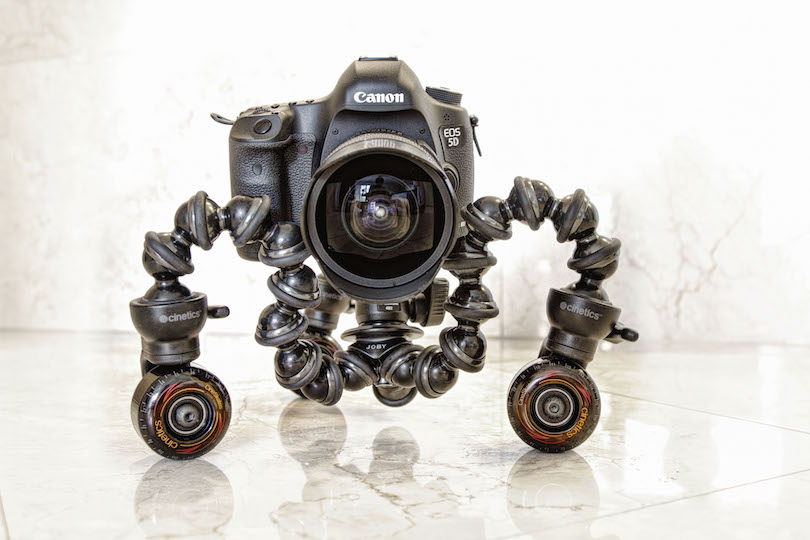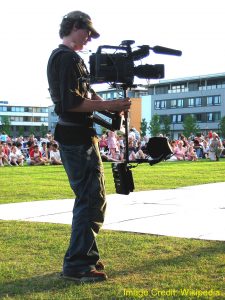
Camera movement is useful to help engage the viewer in the action in a scene, reveal emotion and elements on screen or set the pace. As such, it is essential to know when to use which types of camera movement in order to add information and drama to a scene.
Here is a summary from the video above of the different types of camera movements you will find in filmmaking as well as the types of equipment and gear used to get the perfect shot. The video includes great examples of scenes from movies that illustrate how each movement works and adds depth or interest to the story:
Pan and Tilt
Panning the camera refers to rotating the camera on a horizontal axis (from one side to the other), whereas tilting refers to moving the camera similarly, except vertically (up and down). These are the most common types of camera movement by far.
- Panning or tilting is a handy way to reveal elements in the scene previously not seen on camera.
- They are both often used to follow the natural movement of a scene.
- They can be an effective type of camera movement to involve the viewer in an on-screen character’s emotional state. For example, by revealing to the viewer a shocking revelation at the same time the character sees it, via panning or tilting, the audience is better able to empathize with the character’s shock.
- Smooth pan and tilt movements require little more than a steady hand or a fluid head mounted on a tripod
Dolly and Trucking
An excellent way to add a professional touch to a film’s camera work is to add dolly and truck work to a scene. A dolly movement moves the camera closer to or farther away from a character. A truck movement is done by moving a camera from side to side to set the pace or follow character’s movement.
- A dolly move can be used, for example, to emphasize a character’s expression during important dialogue scenes by moving the camera in tight on his or her face.
- A truck move is a great way to provide contrast in camera movement from one scene to the next to indicate to viewers a change in pace.
- Dolly and truck moves are performed using a wheel, track or slide dolly.
In order to accomplish tracking shots in which the camera moves beyond a stationary position, like the dolly and truck moves, it is often necessary to mount the camera on some sort of equipment or platform in order to get a smooth and stable shot.
Wheel Dollies, Track Dollies and Sliders
A camera dolly is a platform on which a camera is mounted that is pushed on rails or a slider while filming. Dollies on wheels or tracks are better for mounting heavy camera equipment, whereas sliders, usually a camera mounted directly to a single rail, are used for smaller, handheld cameras. Common items like skateboards, wheelchairs and wheeled toys on tabletops can all be used with your camera to get the perfect dolly and truck movement.
Sled and Vest Systems
 When complex camera moves are required for intricate scenes but the movement in the scene entails the risk of dolly tracks being seen, a sled and vest system is the best way to go. These are most often referred to as “steadicams” or “glidecams” (named after their makers) and consists of a weighted camera sled, an elastic arm to absorb the operator’s movement, and a vest to distribute the weight of the equipment over the operator’s body. The system is, of course, not entirely immune to human movement and, as such, requires the camera operator to walk with their knees bent taking heel-to-toe steps in order to minimize the transfer his or her movement to the video footage.
When complex camera moves are required for intricate scenes but the movement in the scene entails the risk of dolly tracks being seen, a sled and vest system is the best way to go. These are most often referred to as “steadicams” or “glidecams” (named after their makers) and consists of a weighted camera sled, an elastic arm to absorb the operator’s movement, and a vest to distribute the weight of the equipment over the operator’s body. The system is, of course, not entirely immune to human movement and, as such, requires the camera operator to walk with their knees bent taking heel-to-toe steps in order to minimize the transfer his or her movement to the video footage.
Booms
A boom essentially consists of a camera attached to an arm of varying lengths that can pivot through a fixed point. This can be used for movements similar to pan and tilt movements. The boom allows for low and high angle shots. This system requires far more setup time because of the multiple pieces of equipment that must be assembled. So shots requiring boom movement require planning in advance of your shoot. Camera poles are another simple form of boom being used often these days, too.
A special thanks to Videomaker.com for providing this embeddable video through their VideoMaker.com YouTube channel! Check them out for TONS of great filmmaking tips and tutorials.
Comments are closed.